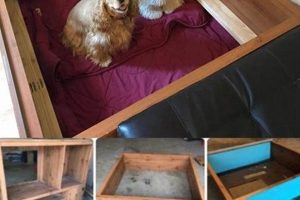A self-constructed daybed represents a furniture project undertaken by individuals to create a versatile seating and sleeping surface. This construction typically involves utilizing repurposed materials, modifying existing furniture, or building from readily available lumber and hardware. The final product serves as a dual-purpose item, functioning as a sofa during the day and a bed for sleeping or lounging.
The appeal of creating a custom piece lies in its cost-effectiveness and adaptability. Constructing such furniture allows for significant savings compared to purchasing a commercially manufactured equivalent. Furthermore, it provides the opportunity to tailor dimensions, materials, and aesthetics to specific spatial requirements and personal preferences, resulting in a unique and personalized addition to a home. Historically, similar projects have provided practical and affordable solutions for furnishing living spaces, particularly during times of economic constraint or when customized solutions were unavailable.
Subsequent sections will detail various design considerations, construction techniques, material options, and finishing methods relevant to successful furniture creation. These will cover aspects such as frame construction, mattress support systems, aesthetic treatments, and safety considerations, providing a comprehensive guide for undertaking this type of project.
Essential Guidelines for Construction
The following guidelines address critical aspects of constructing a self-made daybed. Adherence to these recommendations will enhance the structural integrity, aesthetic appeal, and overall safety of the finished furniture.
Tip 1: Frame Reinforcement: Prioritize robust frame construction. Corner joints should be reinforced with metal brackets or wood blocks. The use of screws and wood glue is essential for long-term stability.
Tip 2: Mattress Support: Ensure adequate mattress support. Slats should be spaced no more than 4 inches apart to prevent sagging. Consider using a solid platform for increased support, particularly for heavier mattresses.
Tip 3: Material Selection: Choose materials appropriate for intended use and environment. Softwoods are suitable for lighter-duty frames, while hardwoods offer superior durability. Outdoor applications require weather-resistant materials and finishes.
Tip 4: Accurate Measurements: Meticulously verify all measurements before cutting materials. Discrepancies can lead to structural instability and aesthetic imperfections. Double-check dimensions against mattress size.
Tip 5: Secure Fasteners: Employ appropriate fasteners for joining materials. Screws should be of sufficient length and gauge to provide a secure hold. Pilot holes are recommended to prevent wood splitting.
Tip 6: Finishing Techniques: Apply a protective finish to the completed frame. This can include paint, stain, or sealant, depending on the chosen material and desired aesthetic. Proper surface preparation is critical for a durable finish.
Tip 7: Safety Considerations: Prioritize safety during construction. Wear appropriate safety gear, including eye protection and gloves. Sand edges and corners to prevent splinters and sharp edges.
By implementing these guidelines, individuals can construct a durable, aesthetically pleasing, and safe piece of furniture. The resulting structure will provide long-term functionality and complement the surrounding environment.
The subsequent section will provide insights on design adaptations and customizations to tailor the structure to meet specific user requirements and aesthetic preferences.
1. Frame Strength
Frame strength is a paramount consideration in the construction of a self-built daybed, influencing its stability, durability, and safe load-bearing capacity. Inadequate frame integrity can lead to structural failure, rendering the furniture unusable and potentially hazardous.
- Material Selection and Load Capacity
The choice of material directly correlates with the frame’s ability to withstand weight and stress. Hardwoods, such as oak or maple, possess superior strength compared to softwoods like pine. Utilizing appropriate lumber grades and considering the wood’s density are critical factors in determining the suitable weight limit. For instance, a frame constructed from low-grade pine will exhibit significantly less load-bearing capacity than one built from high-grade oak, potentially leading to sagging or collapse under normal use.
- Joint Construction and Stability
The methods used to join frame components profoundly impact the overall strength of the structure. Mortise and tenon joints, dovetail joints, and properly reinforced corner joints provide superior stability compared to simple butt joints secured with nails. Reinforcement can be achieved through the addition of metal brackets, wood glue, and screws, strategically placed to distribute stress across the joint. A frame employing poorly constructed joints will be susceptible to racking, loosening, and eventual failure.
- Support Structure and Weight Distribution
The internal support structure plays a critical role in distributing weight evenly across the frame. Crossbeams, center supports, and strategically placed slats contribute to the overall stability and prevent localized stress points. Insufficient support can lead to sagging in the middle or uneven weight distribution, compromising both the comfort and longevity. The spacing and dimensions of these supporting elements must be carefully calculated to accommodate the intended load.
- Fastener Selection and Security
The type and quality of fasteners used to secure the frame components contribute directly to its long-term integrity. Screws, rather than nails, provide superior holding power and resistance to pulling forces. The length and gauge of the screws must be appropriate for the thickness and density of the materials being joined. Furthermore, the use of pilot holes prevents wood splitting and ensures a secure, lasting connection. Inadequate fastener selection can result in loose joints and diminished structural integrity.
The interconnectedness of material selection, joint construction, support structure, and fastener selection demonstrates the holistic approach required to ensure adequate frame strength. Compromising on any of these elements will negatively impact the overall stability and longevity of the completed project. By carefully considering these factors, individuals can construct a durable and safe piece of furniture.
2. Mattress Support
Mattress support is a critical aspect of self-constructed daybeds, directly impacting user comfort, mattress longevity, and the structural integrity of the overall design. The effectiveness of the support system dictates the bed’s abil
ity to provide proper spinal alignment and prevent premature wear of the mattress. A well-designed support structure ensures even weight distribution and minimizes the risk of sagging or deformation.
- Slat Spacing and Load Distribution
Slat spacing plays a vital role in distributing weight evenly across the mattress. Excessive spacing allows the mattress to sag between the slats, leading to discomfort and accelerated wear. Industry recommendations typically advise spacing slats no more than four inches apart. Closer spacing provides enhanced support and extends the lifespan of the mattress. For instance, a platform with slats spaced six inches apart will likely result in noticeable mattress sagging over time, whereas a three-inch spacing will offer more consistent support.
- Material Strength and Deflection Resistance
The material used for the support structure must possess sufficient strength to resist deflection under load. Solid wood slats, particularly hardwoods, offer greater resistance to bending compared to weaker materials such as softwood or composite wood products. Deflection can compromise the support system’s effectiveness, leading to uneven weight distribution and discomfort. A hardwood slat system will maintain its shape and provide consistent support, while a system constructed from weaker materials will exhibit greater deflection under the same load.
- Platform Construction and Surface Area
An alternative to slats is a solid platform, which provides a continuous support surface. This construction method distributes weight uniformly and eliminates the potential for sagging between slats. The platform material should be sufficiently thick and rigid to prevent flexing under load. For example, a daybed utilizing a 3/4-inch plywood platform will offer significantly more support than one using a thinner, more flexible material, resulting in improved mattress longevity and user comfort.
- Center Support and Structural Reinforcement
For larger self-made daybeds, a center support is essential to prevent sagging and maintain structural integrity. This support provides additional reinforcement along the central axis of the frame, particularly when supporting heavier mattresses or multiple users. The absence of a center support can lead to premature failure of the frame and uneven weight distribution. Implementing a center support, especially for frames exceeding standard lengths, enhances stability and ensures long-term durability.
In summary, the connection between mattress support and the project lies in the direct impact of the support system on user comfort, mattress lifespan, and structural integrity. Whether utilizing slats, a solid platform, or a combination of both, the design and construction of the support system are crucial for ensuring a comfortable, durable, and long-lasting furniture piece. Prioritizing these elements contributes to a superior and more functional end product.
3. Material Durability
Material durability represents a critical factor influencing the lifespan and functionality of any self-constructed daybed. The selection of appropriate materials directly determines the furniture’s ability to withstand daily use, environmental factors, and the inevitable stresses associated with prolonged occupancy. Consequently, neglecting material durability during the construction phase invariably leads to premature deterioration, structural instability, and ultimately, a reduction in the furniture’s overall value and utility. For instance, constructing a frame from untreated softwood in a humid environment will result in rapid decay due to moisture absorption and fungal growth. This, in turn, compromises the frame’s integrity and necessitates costly repairs or complete replacement.
The implications of material choice extend beyond the frame to encompass all components of the self-constructed daybed. The selection of fabrics for upholstery, the type of finish applied to the wood, and even the hardware used for assembly must be considered within the context of long-term durability. Outdoor applications demand weather-resistant materials that can withstand exposure to sunlight, rain, and temperature fluctuations. Indoor applications, while less susceptible to environmental extremes, require materials that are resistant to abrasion, staining, and general wear and tear. An example would be choosing outdoor-rated fabric for cushions intended to live outside, preventing premature sun damage. In contrast, a woven fabric might be a preferred option for indoors to create a comfortable and inviting space.
In conclusion, an understanding of material properties and their resistance to various environmental and usage-related stresses is paramount for successful furniture construction. Selecting durable materials, appropriate for the intended application, directly translates to a longer lifespan, reduced maintenance costs, and enhanced user satisfaction. The challenges lie in balancing cost considerations with the need for lasting performance; however, prioritizing durability from the outset proves to be a prudent investment, ensuring the completed structure remains functional and aesthetically pleasing for years to come. These durable components are then an asset to the diy daybed.
4. Design Aesthetics
Design aesthetics plays a pivotal role in the creation of a self-constructed daybed, influencing its visual appeal and its integration within the surrounding environment. Beyond mere functionality, the aesthetic qualities of the furniture contribute significantly to the overall ambiance of the space it occupies and the satisfaction derived from its use.
- Form and Silhouette
The overall form and silhouette dictate the visual presence. Clean, geometric lines can evoke a modern sensibility, while more ornate curves suggest a traditional aesthetic. For instance, a minimalist frame with sharp angles conveys a contemporary feel, whereas a frame incorporating scrolled arms and a tufted back aligns with a more classic design. Careful consideration of the existing architectural style and dcor is necessary to ensure a harmonious integration.
- Material Palette and Texture
The selection of materials and their textures contribute significantly to the visual and tactile experience. Natural wood tones can create a warm and inviting atmosphere, while painted surfaces offer opportunities for introducing color and contrast. The choice of fabric for cushions and upholstery further influences the aesthetic. Linen and cotton provide a casual, relaxed feel, while velvet and leather convey a sense of luxury and sophistication. The interplay of different materials and textures adds depth and visual interest.
- Color Harmony and Contrast
Color harmony and contrast influence the emotional response to the furniture. A monochromatic color scheme can create a sense of calm and serenity, while a vibrant color palette adds energy and visual stimulation. The strategic use of contrasting colors can highlight specific design elements and create focal points. Coordinating colors with existing furnishings and artwork is essential for creating a cohesive and visually pleasing interior. For example, a daybed with a neutral-colored frame allows for the incorporation of bold, patterned cushions to inject personality into the space.
- S
cale and ProportionScale and proportion are crucial for ensuring that the self-made daybed integrates seamlessly within its intended space. A disproportionately large piece can overwhelm a small room, while a too-small piece may appear insignificant and out of place. Careful consideration of the room’s dimensions and the existing furniture is necessary to determine the appropriate scale. The proportions of the frame, cushions, and other design elements should also be carefully considered to achieve a visually balanced and harmonious composition.
The integration of these aesthetic considerations during the design and construction process is paramount for creating a self-constructed daybed that not only serves a functional purpose but also enhances the beauty and character of the surrounding environment. The successful application of these principles transforms a simple piece of furniture into a visually compelling and emotionally engaging addition to the home.
5. Spatial Optimization
Spatial optimization, in the context of a self-constructed daybed, addresses the efficient and effective utilization of available space. The design and dimensions of the furniture must align with the spatial constraints of the intended environment to maximize functionality and minimize clutter. Effective optimization transforms limited areas into versatile living spaces.
- Multifunctional Design and Space Efficiency
Multifunctional furniture designs are pivotal in spatial optimization. A daybed, by its nature, serves dual purposes as seating and sleeping accommodation, consolidating furniture needs. Incorporation of storage beneath the frame, such as drawers or open shelving, further enhances space efficiency by providing supplementary storage solutions. For instance, a small apartment could benefit from a daybed with integrated storage for bedding and seasonal items, thereby reducing the need for additional storage units.
- Dimensional Customization and Adaptability
The ability to customize dimensions represents a core advantage in optimizing space. Self-construction allows tailoring the daybed’s size to precisely fit the available area, avoiding the compromises often encountered with prefabricated furniture. This adaptability ensures efficient use of space in irregularly shaped rooms or areas with specific dimensional limitations. A narrow alcove, for example, could accommodate a custom-sized daybed that would be unsuitable for standard-sized furniture.
- Placement and Traffic Flow Considerations
Strategic placement of the furniture is critical for maintaining optimal traffic flow and accessibility within a room. The daybed should be positioned to avoid obstructing doorways, pathways, or access to other essential furnishings. Consideration of natural light sources and window placement further enhances the spatial dynamics. An example would be situating the furniture near a window to maximize natural light exposure while avoiding placement that impedes movement through the room.
- Vertical Space Utilization and Storage Solutions
Exploiting vertical space through integrated storage solutions contributes to overall spatial optimization. Attaching shelving units or cabinets above the furniture can provide additional storage without consuming valuable floor space. This approach is particularly effective in small living areas where floor space is limited. Installing shelves above a daybed to hold books or decorative items is a practical example of maximizing vertical space and enhancing storage capacity.
These facets highlight the integral relationship between spatial optimization and the design. By prioritizing multifunctional design, dimensional customization, strategic placement, and vertical space utilization, individuals can maximize the efficiency of living spaces through effective furniture integration.
6. Construction Safety
Construction safety constitutes an indispensable element in the execution of furniture projects, specifically in the creation of a self-constructed daybed. A direct correlation exists between adherence to safety protocols and the successful, injury-free completion of such projects. The absence of appropriate safety measures elevates the risk of accidents, ranging from minor cuts and abrasions to more severe injuries involving power tools and structural failures. Consider, for example, the use of a power saw without proper eye protection; this can result in severe eye damage from flying debris. Similarly, failing to secure lumber properly before cutting can lead to kickback, potentially causing serious injury. Therefore, integrating construction safety into every phase of the furniture’s development is critical.
The importance of construction safety extends beyond personal well-being to influence the quality and longevity of the finished product. Securely fastened joints, properly aligned components, and structurally sound frames are direct outcomes of a safe and methodical construction process. In contrast, a rushed or carelessly executed build, often a consequence of neglecting safety precautions, can result in structural weaknesses and aesthetic imperfections. An improperly assembled frame, for instance, may exhibit instability or uneven weight distribution, compromising the furniture’s intended functionality and durability. Likewise, inadequate sanding or finishing techniques, often arising from a lack of attention to detail due to prioritizing speed over safety, can detract from the overall appearance and tactile quality of the piece.
Ultimately, integrating safety protocols into the creation of a furniture piece represents a multifaceted investment. It not only safeguards against injury but also contributes to the creation of a durable, aesthetically pleasing, and functional addition to the home. While challenges may arise in maintaining vigilance and adhering to safety guidelines throughout the project’s duration, the benefits, both in terms of personal safety and the quality of the finished product, significantly outweigh the risks. A comprehensive understanding and proactive implementation of safety measures transform the building process into a fulfilling and rewarding endeavor, ensuring the creation of a valuable and long-lasting asset.
7. Finishing Technique
Finishing technique, within the context of a self-constructed daybed, represents the culmination of the construction process, influencing both the aesthetic appeal and the long-term protection of the structure. The applied finish functions as a barrier against environmental factors, such as moisture and ultraviolet radiation, thereby extending the lifespan of the materials. An improperly executed finish can lead to premature deterioration, discoloration, and structural weakening. For instance, failing to apply a sealant to wood surfaces exposed to high humidity can result in warping, cracking, and fungal growth. Conversely, a carefully applied, durable finish enhances the wood’s natural grain, provides a smooth tactile surface, and protects against wear and tear, thereby preserving the integrity and aesthetic value of the furniture.
The selection of an ap
propriate finishing technique depends on various factors, including the type of material used in the daybed’s construction, the intended environment, and the desired aesthetic outcome. Wood finishes encompass a spectrum of options, ranging from penetrating oils and stains to varnishes and lacquers, each offering distinct levels of protection and visual characteristics. Applying a stain allows for the alteration of the wood’s color, while a varnish provides a protective layer against scratches and moisture. Metal components may require powder coating or painting to prevent corrosion and enhance their appearance. Fabric upholstery benefits from stain-resistant treatments to protect against spills and soiling. An example includes the application of a marine-grade varnish on outdoor furniture to withstand exposure to the elements, while a non-toxic, water-based finish might be preferred for indoor furniture to minimize off-gassing and ensure user safety.
In summary, finishing technique is not merely an aesthetic consideration but a critical element in the overall durability and longevity. The correct application protects the structure from environmental damage, enhances its appearance, and contributes to user safety. Challenges involve selecting the appropriate finish for the material, environment, and desired aesthetic, as well as mastering the application techniques to achieve a uniform and durable result. Understanding the relationship between material properties, environmental factors, and finishing options is essential for creating a functional, aesthetically pleasing, and long-lasting furniture piece.
Frequently Asked Questions About Furniture Creation
The following questions address common inquiries regarding the construction process, aiming to clarify key considerations and potential challenges.
Question 1: What wood type is most suitable for furniture intended for outdoor use?
For outdoor applications, rot-resistant wood species such as cedar, redwood, or teak are recommended. These woods naturally contain oils that deter insects and resist decay caused by moisture exposure.
Question 2: How can one prevent wood from splitting when driving screws?
Drilling pilot holes prior to inserting screws is essential. The diameter of the pilot hole should be slightly smaller than the screw’s core diameter to allow the screw threads to grip the wood without causing it to split.
Question 3: What is the recommended slat spacing for adequate mattress support?
Slat spacing should not exceed four inches. Closer spacing provides enhanced support and prevents mattress sagging, extending the mattress’s lifespan and ensuring user comfort.
Question 4: How does one ensure a smooth finish when applying paint or varnish?
Proper surface preparation is crucial. Sanding the wood to a smooth surface, followed by the application of a primer or sealer, creates an optimal base for the finish. Multiple thin coats, with light sanding between coats, yield the best results.
Question 5: What safety precautions should be observed when using power tools?
Wearing appropriate safety gear, including eye protection, ear protection, and respiratory protection, is essential. Familiarizing oneself with the tool’s operation manual and maintaining a clean, well-lit workspace are also critical.
Question 6: How can the stability of corner joints be enhanced during frame construction?
Reinforcing corner joints with metal brackets or wood blocks significantly enhances stability. The use of both screws and wood glue ensures a strong and durable connection, preventing racking and loosening over time.
These answers provide foundational knowledge for navigating challenges commonly encountered during furniture construction. Prioritizing material selection, precise assembly, and safety protocols will contribute to a successful outcome.
The subsequent section will delve into case studies, illustrating successful implementations of these techniques and providing real-world examples of furniture projects.
Conclusion
This exploration of diy daybed construction has emphasized the multifaceted considerations involved in creating a functional and aesthetically pleasing piece of furniture. Frame strength, mattress support, material durability, design aesthetics, spatial optimization, construction safety, and finishing techniques each contribute significantly to the project’s success. A comprehensive understanding of these aspects is essential for achieving a durable, safe, and visually harmonious end result. Improper attention to any of these areas can compromise the structural integrity, longevity, and overall utility of the furniture.
The undertaking of constructing a diy daybed represents a significant investment of time, resources, and skill. While the potential for customization and cost savings is considerable, the commitment to meticulous planning, execution, and adherence to safety protocols cannot be overstated. Those embarking on such a project should approach it with a clear understanding of the technical challenges involved and a dedication to achieving a high standard of craftsmanship. The creation of a durable and personalized furnishing offers lasting utility and satisfaction.







